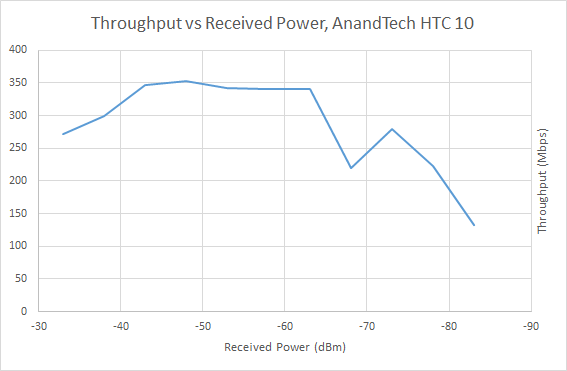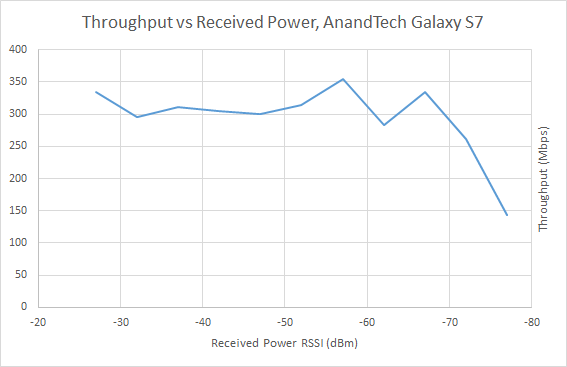The HTC 10 Review
by Joshua Ho on September 19, 2016 8:00 AM ESTWiFi Performance with Ixia IoT
As previously discussed, RF testing has always been a major unknown to some extent because environmental factors make it extremely difficult to tell exactly what is going on with the system. I don’t think it really needs to be said but previous reviews and any controversy regarding the quality of RF has always lead to a ring of confusion and back and forth with no clear-cut answers, at least in the public domain. The Transformer Prime and Pixel C reception issues have all been cases where I’ve seen a lot of confusion over whether a problem really existed in the hardware, software, or with the end user.
Most people really don’t have any understanding of how wireless transmission works, probably because it’s not really something you can see. As far as I know, no one is capable of seeing radio waves, even at high frequencies like 60 GHz. Of course, the problem is that for quite some time our testing was also not really ideal for seeing the quality of an RF implementation. While iPerf does provide some useful data, free space testing means that we’re dealing with channel conditions that inherently cannot be controlled. As a result, the only sensible test we could do with iPerf was focus on maximum throughput in the best conditions we could provide. The only thing that this can highlight is the upper bound of efficiency for WiFi due to the carrier sense multiple access scheme in most cases, and rarely detects a whole class of problems that affect user experience on WiFi.
In order to test these things we’ve moved to using a proper testing system that is actually used by at least a few OEMs today, namely Ixia IoT. While we discussed the possibilities for testing, at this time due to the RF isolation chamber used we are limited to AP simulation only, so we can’t properly simulate clients in the channel without restricting ourselves to a single spatial stream for both the AP and client. This wouldn’t be a very useful test if set up in this manner as most devices today that we’re testing have support for two spatial streams, and many routers have three or even four spatial streams at this point.
The first set of results we can talk about that will be of interest is rate vs range. This is a fairly simple test at a conceptual level, as it simply tries to see how well a device can maintain its performance in the face of reducing signal to noise ratio for a given modulation and coding scheme. This is a good high level test of how well a device can maintain a connection as reception degrades. In this test the HTC 10 had an initial RSSI of -28 dBm while the GS7 was at -21 dBm and the iPhone 6s at -22 dBm, which allows us to calculate the path loss and determine the RSSI as a function of the transmit power.
The results of this test are interesting to say the least. Off the bat, every device had different RSSIs measured, so this meant that everything had different levels of path loss. The HTC 10 seemed to have the most path loss, while the Galaxy S7 and iPhone 6s were functionally identical. However it looks like RSSI is really an insufficient metric here because while the iPhone 6s was able to reach maximum throughput using NSS 2 MCS 8, the HTC 10 and Galaxy S7 did its best at NSS 2 MCS 4 or 5. I suspect this may be just due to placement as device positioning strongly affects MIMO as receive-side spatial correlation reduces the gains that MIMO can provide. Regardless, the HTC 10 somehow manages to beat the Galaxy S7 through much of the curve, but for some reason suffers from a reduction in throughput at higher transmit power. It's worth mentioning though that this test doesn't allow for testing of antenna gain or similar tests. Given various levels of futzing about with the device positioning in the test chamber I'm fairly confident that the Galaxy S7 is consistently better with regard to path loss, so even if it doesn't perform as well at a given RSSI it tends to have a higher RSSI than the HTC 10 by about 5 dBm which is fairly significant. I'm hoping to get some true antenna efficiency measurements with 3D plots in the near future so we can really give some real data on everything relevant here but for now this test highlights fairly well how WiFi performance varies.
Finally, the other test that we can run at this time is the roaming latency test, which tests how well a device can hop from one access point to another as the received transmit power rises and falls. If you ever rely on WiFi to work as you walk around any building larger than a single apartment unit, you’re going to feel the effects of high roaming latency as VOIP calls or any real-time network application will either experience interruption or drop altogether if roaming is not implemented properly.

Like the Galaxy S7, the HTC 10 really struggles with WiFi roaming as it seems almost universal that Android OEMs aren't really paying attention to anything that we don't test. The HTC 10 tended to not fail handover as often as the Galaxy S7 with only one failure out of 64 trials and fairly consistent latency around 110ms though. This is a bit of a surprise considering that the HTC 10 is generally considered in the broader discourse to have worse WiFi across the board compared to the Galaxy S7. Considering how much smaller HTC is this is really kind of strange to see. Just about anything will outperform the Pixel C though. Either way, HTC still should improve here, especially when considering how most schools and offices need good WiFi to make up for areas with cellular coverage gaps.













183 Comments
View All Comments
Zoomer - Thursday, September 22, 2016 - link
It's not ten times better in the way that a BMW M7 isn't ten times better than a Tata Nano. That doesn't make it vastly better than a BLU.ACM.1899 - Friday, September 23, 2016 - link
i meant if your LCD, Speakers,Buttons, antennas, Charging circuit ... maintain their quality in long term. AND how REPAIRABLE it is.or more importantly Battery.
or the Rom lasts longer before becoming laggy. or how manufacturers support the phone or developers with their custom roms.
ACM.1899 - Friday, September 23, 2016 - link
not the best example though , but i see your point..because almost everybody can afford the best smartphone and when spending a lot of money , he/she would rather not to spend anytime soon.
like you buy shoes ; you can spend 150$ (50+50+50, three new cheap shoes every year) or 150$ (good quality shoes) every 3 years.(fixed prices and incomes)
ACM.1899 - Friday, September 23, 2016 - link
and of course it depends on how you use it.if you run a lot then you need good shoes.but if you just dial and text then a nokia 3310 is more than enough for you.
techconc - Monday, September 26, 2016 - link
I have no issue with you feeling good about your $60 phone. That's great. I'm truly happy for you. That said, your claim that purchasing high end phones isn't sustainable is provably incorrect. For many people, the smartphone is the computing device that people use for the better part of the day. It shouldn't be difficult to understand that even people with lower income would choose to indulge on this particular product category.Impulses - Thursday, September 22, 2016 - link
Glad you put this review out Josh, having read it I'm a little more inclined to pick a 10 up if the Pixels disappoint me... Despite all the enthusiast belly aching, people tend to keep phones longer those days and are thus much more likely to pick up a flagship model later in it's cycle.Shoot, I went thru three phones in three years (all HTC) before finally keeping one longer than that, still clinging to my N5... Not using my phone for gaming or as my primary camera has really made things like battery life, software, general design, and unique features the biggest differentiators.
Good old N5 got at least two of those right, really starting to want something with better battery life even after a cell swap and wireless chargers all over the house... Gotten quite used to those tho, hoping the Pixel's glass back means it's back in.
nukmichael - Sunday, September 25, 2016 - link
Why NFC looks still active in the battery test ?? Shouldn't be closed?DaFireStorm - Tuesday, September 27, 2016 - link
Great review. I use an HTC 10 and have become of the WiFi woes of this device but I think this may be the only review to have picked up on the WiFi problems.Badelhas - Tuesday, October 17, 2017 - link
Hi there. I just upgraded from the M8 and the wifi is not Wi-Fi range is very weak, used to be able to watch videos on the bedroom or kitchen and now it's impossible. Am I the only one? Is there anything we can do to fix it?Cheers
axcelred - Tuesday, November 22, 2016 - link
Thank you for this review, it really helped me make a decision. I was looking at so many midrange and high end flagship phones but wanted an overall good experience and low light camera as my main point to shoot. Mainly in home or social gathering use that has mid to subtle lighting and can pick up details in the shadows with less noise. Coming from a camera on a Lumia, it's hard to let go ir find something that performed similarly. With the current Black Friday 2016 - 200 dollars off, I purchased one; everything in the price range of 399-499, didn't have great reviews for these conditions and even some of the higher end phones. It may not be the fastest or have the latest processor, but it is stable, solid, and has a great community from HTC's commitments and XDA surrounded it and that is important. Really appreciate this and the in-depth reviews this site provides.